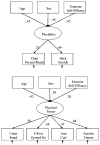Correlates of functional fitness in older adults
- PMID: 19005931
- PMCID: PMC2845438
- DOI: 10.1080/10705500802365557
Correlates of functional fitness in older adults
Abstract
Background: Self-efficacy has been shown to be both an antecedent and determinant of behaviors such as physical activity and may explain variance in the performance of functional tasks among older adults.
Purpose: The objectives of the current study were: first, to identify potential latent factors of functional fitness (i.e., the ability to perform activities of daily living) among older adults; and second, to determine the extent to which self-efficacy contributed to the variance in functional fitness over and above other known correlates.
Methods: Older adults (n = 190, M age = 69.4 years) completed a functional fitness test battery, maximal graded exercise test, and demographics and self-efficacy questionnaires.
Results: Structural equation modeling supported two latent factors of functional fitness representing "Flexibility" and "Physical Power." Further analyses indicated sex as the sole significant correlate of Flexibility. Greater Physical Power was associated with being male, younger, and having higher self-efficacy.
Conclusions: These results support the role of self-efficacy as a correlate of performance on functional tasks. Targeting flexibility and physical power to improve functional fitness among older men and women, respectively, warrants examination.
Figures
Similar articles
-
Trajectory of declines in physical activity in community-dwelling older women: social cognitive influences.J Gerontol B Psychol Sci Soc Sci. 2009 Sep;64(5):543-50. doi: 10.1093/geronb/gbp049. Epub 2009 Jun 15. J Gerontol B Psychol Sci Soc Sci. 2009. PMID: 19528360 Free PMC article.
-
Assessing outcome expectations in older adults: the multidimensional outcome expectations for exercise scale.J Gerontol B Psychol Sci Soc Sci. 2009 Jan;64(1):33-40. doi: 10.1093/geronb/gbn032. Epub 2009 Jan 29. J Gerontol B Psychol Sci Soc Sci. 2009. PMID: 19181688 Free PMC article.
-
Pathways from physical activity to quality of life in older women.Ann Behav Med. 2008 Aug;36(1):13-20. doi: 10.1007/s12160-008-9036-9. Epub 2008 Aug 2. Ann Behav Med. 2008. PMID: 18677453 Free PMC article.
-
Effects of an Exergame Software for Older Adults on Fitness, Activities of Daily Living Performance, and Quality of Life.Games Health J. 2018 Oct;7(5):341-346. doi: 10.1089/g4h.2017.0079. Games Health J. 2018. PMID: 30325234 Free PMC article.
-
Physical activity, disability, and quality of life in older adults.Phys Med Rehabil Clin N Am. 2010 May;21(2):299-308. doi: 10.1016/j.pmr.2009.12.006. Phys Med Rehabil Clin N Am. 2010. PMID: 20494278 Review.
Cited by
-
Does functional fitness decline in accordance with our expectation? - a pilot study in healthy female.BMC Sports Sci Med Rehabil. 2015 Jul 10;7:17. doi: 10.1186/s13102-015-0012-y. eCollection 2015. BMC Sports Sci Med Rehabil. 2015. PMID: 26167287 Free PMC article.
-
Associations between older adults' physical fitness level and their engagement in different types of physical activity: cross-sectional results from the OUTDOOR ACTIVE study.BMJ Open. 2023 Mar 29;13(3):e068105. doi: 10.1136/bmjopen-2022-068105. BMJ Open. 2023. PMID: 36990489 Free PMC article.
-
Psychophysical Health Factors and Its Correlations in Elderly Wheelchair Users Who Live in Nursing Homes.Int J Environ Res Public Health. 2020 Mar 5;17(5):1706. doi: 10.3390/ijerph17051706. Int J Environ Res Public Health. 2020. PMID: 32150994 Free PMC article.
-
The influence of 3 months of physical exercises and verbal stimulation on functional efficiency and use of free time in an older population under institutional care: study protocol for a randomized controlled trial.Trials. 2017 Aug 11;18(1):376. doi: 10.1186/s13063-017-2114-1. Trials. 2017. PMID: 28800755 Free PMC article. Clinical Trial.
-
The relationship between functional status, physical fitness and cognitive performance in physically active older adults: A pilot study.PLoS One. 2018 Apr 9;13(4):e0194918. doi: 10.1371/journal.pone.0194918. eCollection 2018. PLoS One. 2018. PMID: 29630625 Free PMC article.
References
-
- Arbuckle JL. Full information estimation in the presence of incomplete data. In: Marcoulides GA, Schumacker RE, editors. Advanced structural equation modeling: Issues and techniques. Mahwah, NJ: Lawrence Erlbaum; 1996. pp. 243–278.
-
- Bandura A. Self-efficacy: The exercise of control. New York: W. H. Freeman; 1997.
-
- Bentler PM. Comparative fix indexes in structural models. Psychological Bulletin. 1990;107:238–246. - PubMed
-
- Bentler PM, Bonett DG. Significance tests and goodness of fit in the analysis of covariance structures. Psychological Bulletin. 1980;88:588–606.
-
- Bollen KA. Structural equations with latent variables. New York: John Wiley & Sons; 1989.

